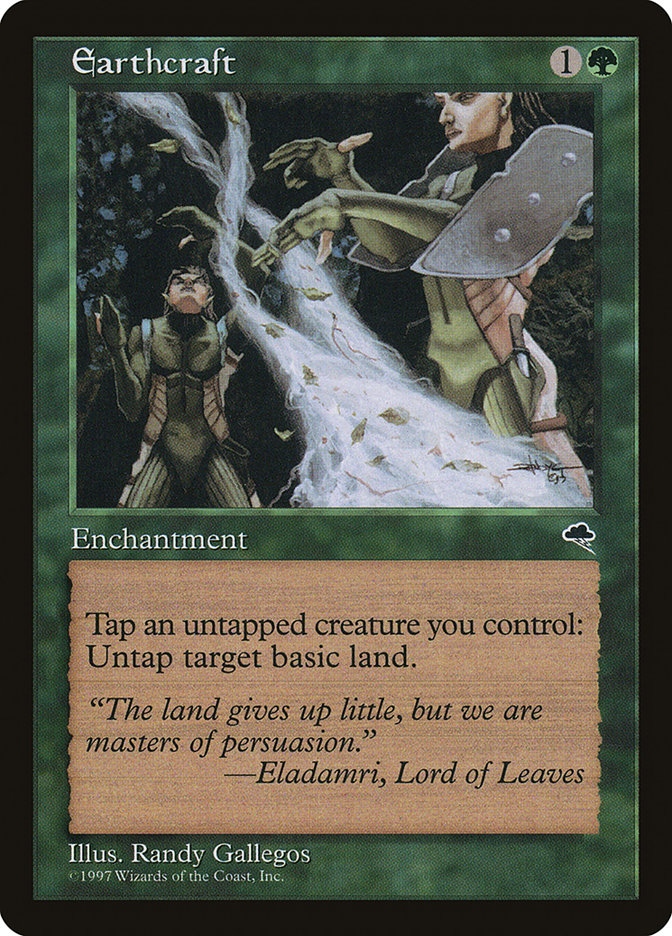Magic the Gathering has proven itself as a timeless game that is going to endure for the foreseeable future. How did that happen? Well, basically the game has moved across generations. There are more players playing today that joined in the last few years than at the beginning of the game. That’s incredibly healthy. Because it has moved to a new generation of players, the game is going to survive when folks like me are forced to give up our cards.
This is not true of most hobby games. Take something like the wargame BattleTech and its counterpart MechWarrior. There was a time in the early to mid-90s when BattleTech was everywhere. We had a Saturday morning cartoon, some toys, a very successful slate of video games, and a lot more. Shoot, even Wizards of the Coast once had a BattleTech CCG. While there are still some successful aspects of the game (like MechWarrior Online) for the most part, all we have left are a dwindling group of players with a similar age range to myself who began playing in the 80s and 90s when the game could be found in bookstores across the world. Barring a comeback of epic proportions (perhaps a live action film or a major video game franchise like Fallout) it’s not likely to last. At some point in time, BattleTech is going to wind down.
Magic isn’t BattleTech or Blood Bowl or Middle-Earth: Collectible Card Game. It’s different. It’s like Dungeons and Dragons.
The benefit of this is that Magic will endure, so you can expect your hobby to continue. Yay Magic! However, the number of Magic cards in print is going to increasingly swell. According to Gatherer, we have roughly 15,000 unique Magic cards out there. Just think about that. That is a huge number of unique elements for this game. That’s in 22 years of making the game. Imagine that by 2020 we will be pushing 20,000 cards, and by 2030, we could have almost 30k. Between specialty products like Commander or Planechase on an annual basis, along with all of the new cards from four sets (and we will likely see even more new cards with the removal of a core set for an expansion set), the results are going to be that we’ll see hundreds and hundreds of cards annually getting printed.
Imagine trying to search 15,000 cards for the right stuff for that Commander deck that you are building today. It’s no wonder that people tend to play the same cards over and over again in many playgroups. Hitting that list is going to require a serious investment of time. It’s not easy to figure out.
There are tons of cards out there that really sing a special tune, but people forget them. Or never knew about them, and frankly, I can’t blame them. Certainly not anymore!
Take a quick look at Foster. Foster is perfect in a lot of decks. And it was printed again in Commander in a good setting with the Prossh, Skyraider of Kher deck. Foster is lucky because it wasn’t on the Reserve List (that ended with Urza’s Block of Happiness and Joy and didn’t make it to Masques Block cards). Yay, Foster! Of course, there are cards on the Reserve List that can never be printed again. And unfortunately, a card such as Corpse Dance or Earthcraft can’t be reprinted in a theme deck for a new generation.
This is true for a lot of major tournament level cards. You cannot reprint City of Traitors or Cursed Scroll, Yawgmoth’s Will or Grim Monolith. New generations of players won’t be able to get their hands on a newly minted Grim Monolith. However, there are also a lot of casual cards that were hit as well, and unique cards such as Phelddagrif, Angus Mackenzie, or Dominating Licid are never going to see print again. While some cards could get printed in a different form (like Xanthic Statue or Lightning Dragon) many are too embedded in the flavor or mechanics of the day to see a new iteration.
Finding these fun cards from days unseen is one of the great things we can do as casually-oriented Magic players. Whether you are dialing it up with a Commander deck or a 60-card fun fest, showing someone up with a Tolarian Entrancer is really intriguing. Casting an Urborg Justice to force someone to sacrifice a bunch of creatures is great. We live for those moments, right?
Right!
So with that in mind, I wanted to grab a handful of cards to discuss from the Wayback Machine that can still be used to impress the Joneses. None of these cards are on the Reserve List, and most are Modern-legal, but it was a good jumping off point for this discussion. Unearth the goods! Find some useful cards that you can apply moving forward. I’ll show you some cards for your builds, and even toss together some quick samples of 60-card decks to demonstrate the sort of shells you can build around, even in Commander.
Let’s take a gander:
A lot of decks that run blue want to block early attacks or send them elsewhere. Blue control or tempo or combo can all benefit from dropping an early blocker to keep your life total sane. And there are a lot of great creatures that you can play that will keep folks from popping your way. Take Fog Bank. Fog Bank is great – it flies, it can block turn after turn without worrying about dying to creature damage, and it’s a strong early blocker. But it does have same weaknesses. For example, it can’t attack when you have an open board, and it’s really awkward when all you do is absorb two damage from that giant trampling beater. And that’s where Dream Fighter can come into play. You block any creature that attacks. Now both it and the Fighter phase out and are gone. No double strike, no trample, and no tricks to play around with. They are both gone, and you’ll get your Fighter back first. Because the attacking creature is gone, you’ll find that players who might normally attack you with a vigilance creature, like Darksteel Sentinel, hoping to keep it open for blocking themselves are suddenly going to stop looking your way. The only issue is that the Fighter can’t block flyers. But if you can have multiple blockers, check this one out and give it a roll. No one is afraid of it, but you’ll find it’ll do a lot to keep you alive.
In a lot of discard decks, most of the triggers that you expect are black (such as Megrim) or colorless (like Geth’s Grimoire). You don’t expect a strong choice in blue. I think that’s why a lot of folks forget about Telekinetic Bonds. Did someone discard a card? Maybe they cycled it. You can tap some mana to untap/tap a permanent and get some additional value out of that card. You can also create a combo deck, like say:
Spells (28)

Discard a card for free to untap something like Blueprints or Arcanis. Tap them to draw your deck. Meanwhile you can activate the Bonds to untap or tap Gilded Lotus and make extra mana to fuel a giant Braingeyser or Staff of Domination for fun and profit.
You don’t need a Bonds or combo shell to make it work. There are many uses of Telekinetic Bonds!
I know that casual players often prefer to have cards that have set results, so they can rely on them. That’s why a card like Recurring Insight is a lot more underplayed than it should be. People want reliability. It’s doesn’t matter to a lot of players if, in practice, Recurring Insight tends to draw you 8-10 cards. They want some boring card like Tidings that never misses. That’s also why equipment like Empyrial Plate gets benched. What if you are in a boardstate where you are topdecking and you draw a Plate? It’s worse than a land, right? It’s bad against discard and such. But once you start playing the Plate, I suspect that you’ll be a bit surprised. How does Reliquary Tower play for you? Because if you are the sort of player that gets a lot of distance from the Tower, holding cards in your hand and such, then the Plate certainly fits. The Plate is a strong element of damage enhancement for your next party.
I think sometimes people just forget that there is a red Pestilence. Despite how long ago the first one was printed, I still spy the occasional Pestilence at the table, but that’s not true of Pyrohemia. Frankly, Pyrohemia is probably better supported in red, the color of damage dealing in droves. You can support it with things like Kumano, Master Yamabushi or Rolling Thunder. Do enough damage to hurt some stuff, and then blow out what’s left without damaging your own life or team that much, and then roll on over your foes. Pyrohemia is here and ready and rock.
I remember running into Mark of Eviction in various casual brews for about a year or eighteen months after Ravnica was released, and then it just disappeared. I was never sure as to why. Take a look at the Mark and you’ll see a pretty useful card. For just one mana, you can slap it on a creature, and then it bounces, along with your Mark, each of your upkeeps. So it’s great tempo if your opponent keeps spending more mana than you to replay a creature, and barring haste or something else, you can basically force them to remove a creature from attacking, and you can switch targets. You get triggers off something like prowess as you replay your Mark, you can use it to self-bounce something of your own that you want to reuse, and don’t forget what this’ll do to someone’s annoying commander. The Mark of Eviction deserves another round in the light.
Creatures (22)
- 4 Merfolk Looter
- 4 Silver Myr
- 4 Rishadan Cutpurse
- 2 Draining Whelk
- 2 Venser, Shaper Savant
- 2 Mulldrifter
- 4 Azure Mage
Lands (24)
- 24 Island
Spells (14)

Here’s a super-quick Mark deck that uses traditional blue tempo cards within a different context. I tried to make this deck as normal and typical as possible, in order to illustrate just how easy it is to slide in Mark of Eviction. There are no special or random cards to this deck, and after seeing it, you could easily build a similar deck from whatever deckstock you have lying around.
The Circle can work as a solid adjunct to some black control strategies. Note one major distinction about the Circle – you can choose who is getting bled for a damage. It’s not the source’s controller, necessarily. It certainly could be! But if you want to take Jenny’s damage and bleed John for a life, you can. So get ready, you can activate it when you take damage from yourself. Did you activate Pestilence (or Pyrohemia above) and hit everyone and everything for one damage? Gain a life and have someone lose one. And as you start to dig into the history of black cards, you’ll find a ton that deal damage to yourself, and you can use that to hit others.
This former Conspiracy card was tossed into a number of Golgari decks that have a “dying” theme. It’s basically a one-sided Fecundity, only you draw a card once/turn, and you wait until the end. Drawing cards is awesome, and drawing cards to keep your deck popping is awesome-er!
Magus in the Middle
I want to finish stuff off by talking about the uber-Magus cycle for a moment. During Time Spiral Block, each set had a five-card cycle that brought a famous (hopefully) artifact, land, or enchantment to creature form. They were collectively known as “Magus of the…” cards.
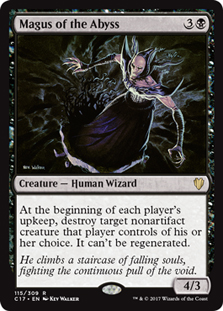
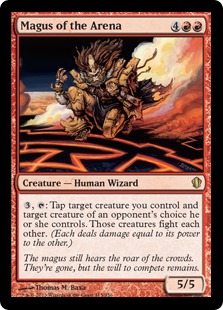
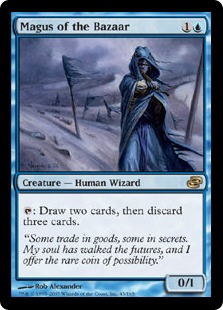
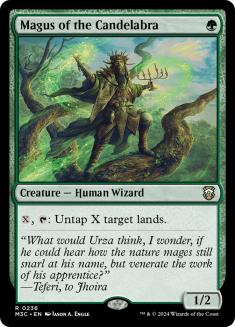
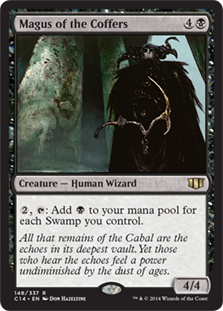
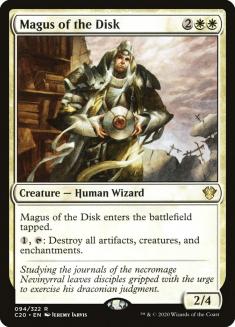
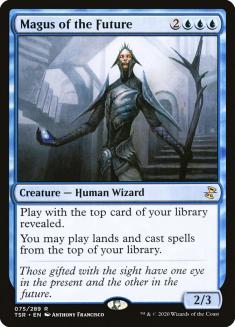
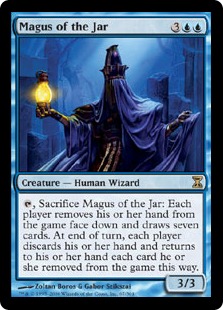
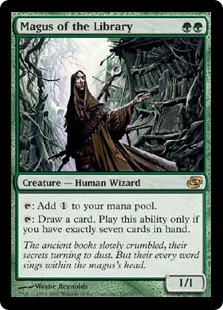
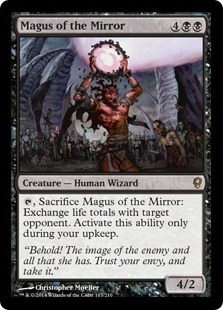
Because many of them brought some serious iconic cards to their respective colors, they increased your options considerably. And guess what? Today, they are almost universally available for bulk rare prices, despite having a lot of power. In fact, two of these (Magus of the Jar and Magus of the Disk) made it to my Underused Hall of Fame. A third one is on my radar for later induction.
Most of these cards are quite good, and heavily underused. Take Magus of the Jar. It’s often better than Memory Jar because after you tap and sacrifice it, you can reanimate it, or graveyard clone it (The Mimeoplasm, Volrath’s Shapeshifter, Body Double). With dedicated creature abuse in your deck, you can easily blow it out. Plus these guys can attack, block, and grab a piece of equipment. They participate in the game, unlike other cards.
Consider Magus of the Library, a copy of Library of Alexandria. Normally, if you don’t have seven-ish cards in your hand, the Library of Alexandria sucks. But the Magus can still be a part of the game. In addition to tapping for colorless mana, you can swing and beat. It’s a pretty useful card for your decks, especially if you are expecting to have a full grip occasionally.
Magus of the Library is not alone. Cursed Scroll has always been a nifty drop, and Magus of the Scroll is even better in some respects, because you get a 1/1 creature too. Yes, you can’t activate it the turn you play it, but since you can attack on the turns you can’t Scroll due to mana issues or a full grip, the Magus of the Scroll has a longer damage range. It’s a strong card to drop and plop. Much like Cursed Scroll, Candelabra of Tawnos is a strong artifact that you want when you can use it, but can often sit around and lack for value. Even if all you are doing is making some mana with Karoo lands like Simic Growth Chamber, it’ll be a useful way to amp up your mana or reuse key lands with abilities (Maze of Ith, as an example). So tossing Magus of the Candelabra makes sense; you increase its flexibility and usefulness considerably.
Unfortunately, a few cards that were en-Magus-ed were anti-creature, and that doesn’t really work well on a creature, like Magus of the Abyss, Magus of the Tabernacle, or perhaps you count Magus of the Moat. We also have the pretty weak Magus of the Arena, which is never going to win any beauty pageants.
Don’t sleep on Magus of the Bazaar either. Bazaar of Baghdad has proven its brokenness for years. Ever since they combined it with Balance (you remove most of your hand, then Balance away your foe’s as well) or with reanimation (Bazaar a Nicol Bolas into your graveyard, and then Shallow Grave it back into play and smash for seven damage and a Mind Twist effect that likely wins the game). These days, Bazaar is a triumphant powerhouse with dredge and other various graveyard effects, but it’s always been a force. Obviously the creature version will be a bit watered down – it has to be. But it still exists. It’s still a presence. You have to respect a Magus of the Bazaar when you see one.
With its inclusion into Group Hug decks since the death of mana burn, Magus of the Vineyard has swapped roles. Now it’s a friendly card from what was once very annoying, but very risky as well. But it still helps to accelerate you, and that’s what really matters, right?
We certainly already know about Magus of the Moon, and Magus of the Future still gets a bit of play, but I haven’t seen any of the other thirteen Magi in decks not run by, well, me, in more than a year or three. So grab your best Magus and let’s get going!
Magus of the Wheel seems to be pretty good too, but I want to get a chance to play it a bunch before adding it to this sort of article. I would love to see additional Magus sorceries. I’m not sure about you, but I could see a Magus of the Balance, Magus of the Mind (Mind Twist), Magus of Time (Timetwister) and Magus of the Regrowth.
In today’s article, we looked at a variety of cards that aren’t getting the play they deserve. We have 15,000 cards now, but it’s just hard to figure things out. From Dream Fighter and Telekinetic Bonds, to Pyrohemia, Mark of Eviction and all things Magus, we have a lot to rock the block.
These cards don’t suck!



